Dinosaurs have always captured the imagination with their immense size and mystery, but some species were so massive that they defy belief. Among the largest creatures to ever walk the Earth, these giants lived millions of years ago, dominating the prehistoric landscapes. From the towering sauropods with their long necks to the titanic titanosaurs, these dinosaurs pushed the boundaries of size, making them some of the most awe-inspiring animals in history. Through fossil discoveries from around the world, paleontologists have been able to piece together the incredible details of these enormous creatures. Each new find not only sheds light on their sheer size but also their unique adaptations for survival. In this list, we explore 20 of the largest dinosaurs ever discovered, delving into their sizes, habitats, and evolutionary significance.
Argentinosaurus
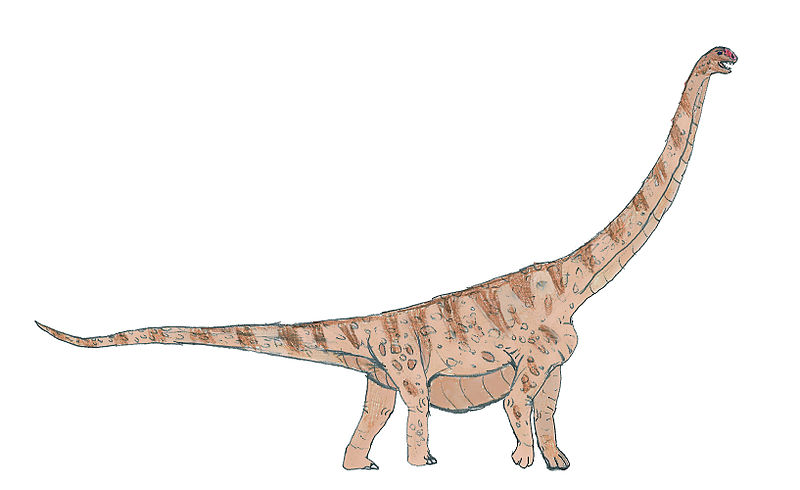
Argentinosaurus is believed to be the largest dinosaur ever discovered, towering above most others. This colossal sauropod reached lengths of up to 100 feet and weighed around 100 tons. Found in Argentina, this dinosaur roamed the Earth during the Late Cretaceous period. Its long neck allowed it to reach the highest branches of trees, feeding on vegetation. Despite its size, it had relatively small, peg-like teeth suited for stripping leaves. Argentinosaurus had a massive barrel-shaped body and sturdy, pillar-like legs to support its immense weight. Its discovery reshaped our understanding of just how enormous dinosaurs could grow.
Patagotitan mayorum
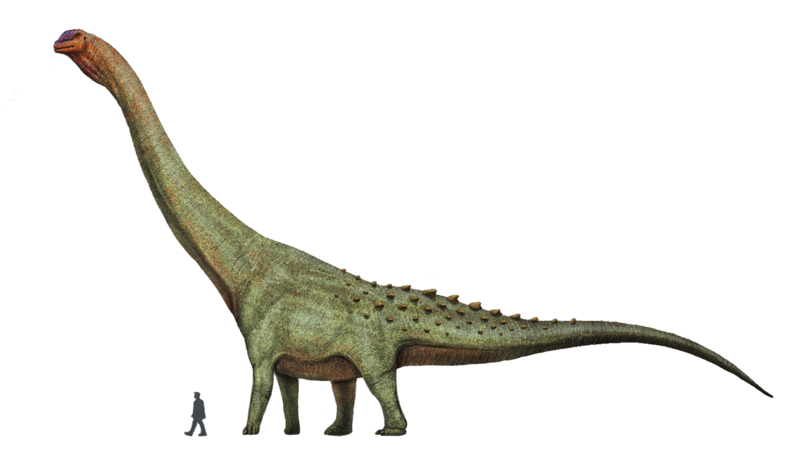
Patagotitan mayorum, another titan of the dinosaur world, was discovered in Argentina in 2014. This dinosaur could stretch up to 122 feet in length, with an estimated weight of 70 to 77 tons. It lived during the Late Cretaceous period and was a close relative of Argentinosaurus. Its sheer size made it one of the heaviest land animals to have ever existed. Patagotitan’s long neck and tail, combined with its immense bulk, required a massive skeletal structure to support its body. The discovery of several bones from multiple individuals helped scientists create a more accurate estimate of its size. It highlights the evolutionary peak of the sauropods, which dominated their ecosystems.
Dreadnoughtus
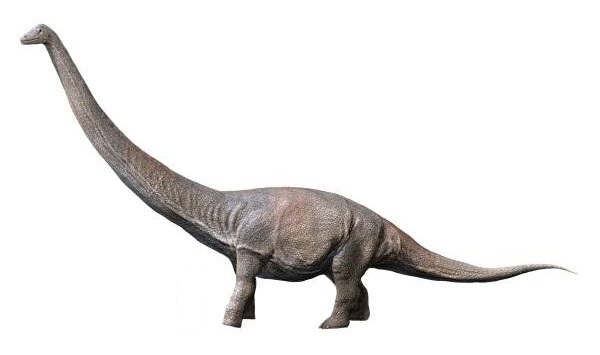
The aptly named Dreadnoughtus was a true behemoth, weighing an estimated 65 tons and stretching nearly 85 feet in length. Found in Patagonia, this titanosaur’s remains are among the most complete ever found for a giant dinosaur. Dreadnoughtus lived approximately 77 million years ago, during the Late Cretaceous period. Its size alone would have deterred even the most fearsome predators of its time. With its long neck, it likely fed on the tallest trees, accessing food sources out of reach for smaller herbivores. This dinosaur’s robust limbs and sturdy frame made it an intimidating presence in its prehistoric world.
Alamosaurus
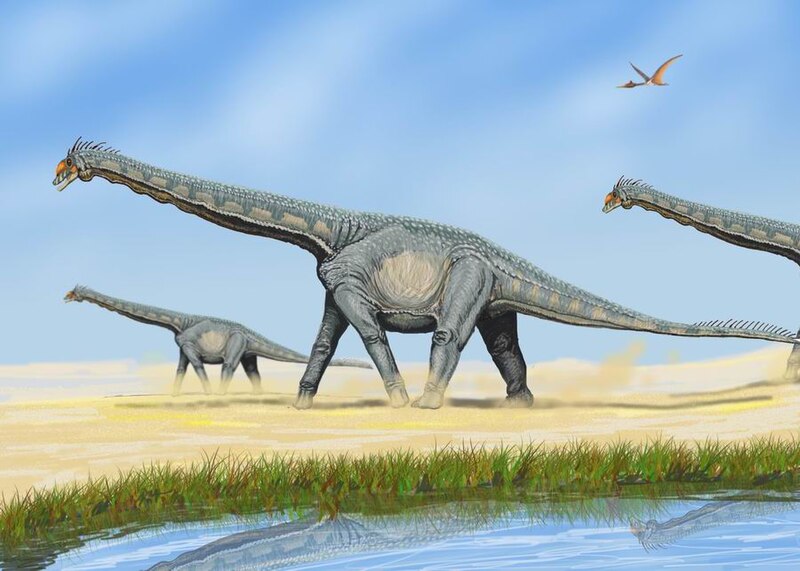
Alamosaurus, a North American giant, was one of the largest dinosaurs from the southern United States. This titanosaur could grow up to 100 feet long and weigh more than 70 tons. Alamosaurus lived during the Late Cretaceous period and had a body built for endurance. Its elongated neck helped it feed on high vegetation, while its massive legs supported its immense bulk. Fossils of Alamosaurus have been discovered in Texas, New Mexico, and Utah, indicating a wide range across the continent. Its strong tail may have been used for defense, delivering powerful strikes to potential predators. The discovery of its fossils in North America highlights the global distribution of these giant sauropods.
Supersaurus
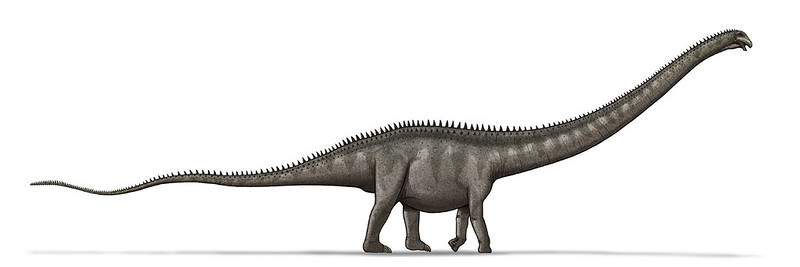
Supersaurus, as its name suggests, was super-sized, with lengths reaching up to 110 feet. This sauropod lived during the Late Jurassic period and was discovered in Colorado, USA. Supersaurus was lighter than other giant sauropods, weighing around 40 tons, but its long neck and tail made it one of the longest dinosaurs ever. Its whip-like tail could have been used defensively or to communicate with others of its kind. Its large body required a continuous supply of plant material, which it likely grazed on from tall trees. Supersaurus had an elongated body structure that allowed it to move relatively efficiently for its size. The discovery of its fossils opened new possibilities for understanding the evolution of massive sauropods.
Futalognkosaurus
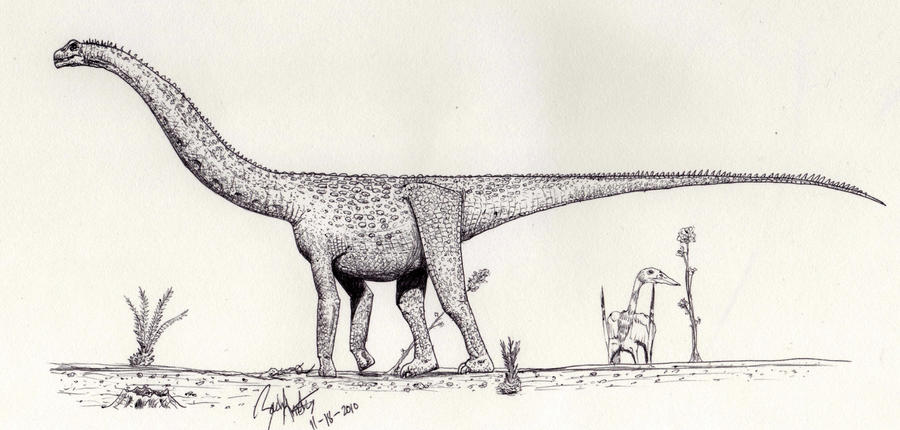
Futalognkosaurus is another massive dinosaur from Argentina, known to have measured around 98 feet in length. Weighing approximately 50 tons, this titanosaur lived during the Late Cretaceous period. Its fossils were discovered in the Neuquén province of Patagonia, where many other giant dinosaurs have been found. Futalognkosaurus had a long, muscular neck and a large, bulky body. Its discovery included vertebrae and pelvic bones, which provided insight into its size and mobility. Unlike some of its lighter counterparts, Futalognkosaurus had an extremely wide hip structure. This, combined with its massive tail, made it an impressive sight.
Paralititan
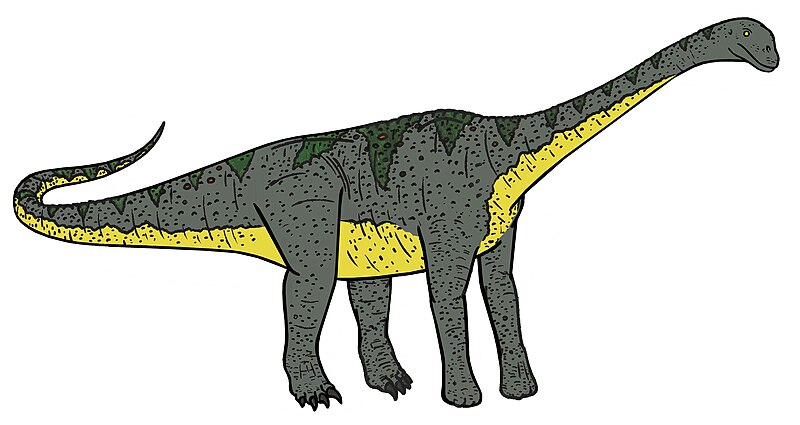
Paralititan was a titanosaur that lived in what is now Egypt, during the Late Cretaceous period. Reaching lengths of up to 100 feet, it weighed around 65 tons, making it one of the largest African dinosaurs. Its fossils were discovered in the Bahariya Formation, a region that was once a lush, coastal environment. Paralititan had a long neck and tail, typical of sauropods, and fed primarily on vegetation. Its size would have made it nearly impervious to predators, though it may have been vulnerable during its juvenile stages. The environment in which it lived, rich with plant life, was perfect for a herbivore of its size. The discovery of Paralititan in Egypt expanded our knowledge of giant dinosaurs in Africa.
Sauroposeidon
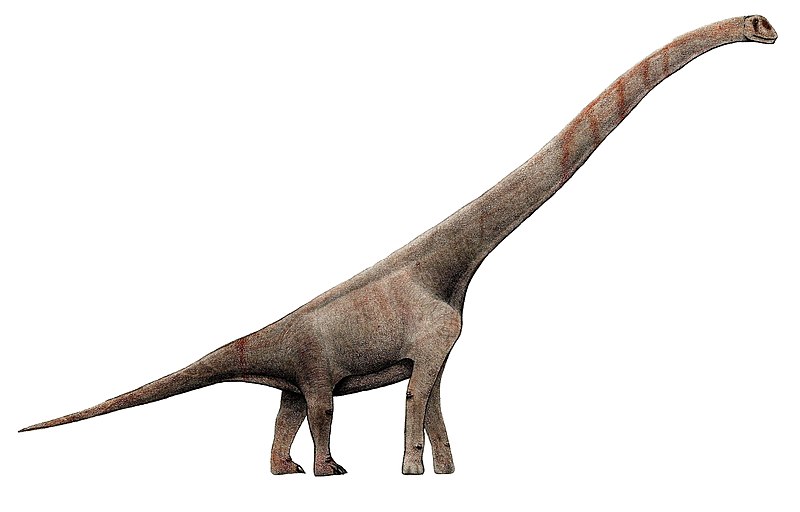
Sauroposeidon was one of the tallest dinosaurs ever discovered, with a neck that could reach up to 56 feet high. Found in Oklahoma, USA, its fossils suggest it was around 112 feet long and weighed over 60 tons. This dinosaur lived during the Early Cretaceous period and fed on treetops that were inaccessible to most other herbivores. Its name, meaning “earthquake god lizard,” is fitting given the massive impact it likely had on its environment. Sauroposeidon had elongated cervical vertebrae, which helped support its incredibly long neck. The discovery of its vertebrae in 1994 led to a reevaluation of sauropod gigantism. Its height gave it a distinct advantage in accessing food in forested areas.
Puertasaurus
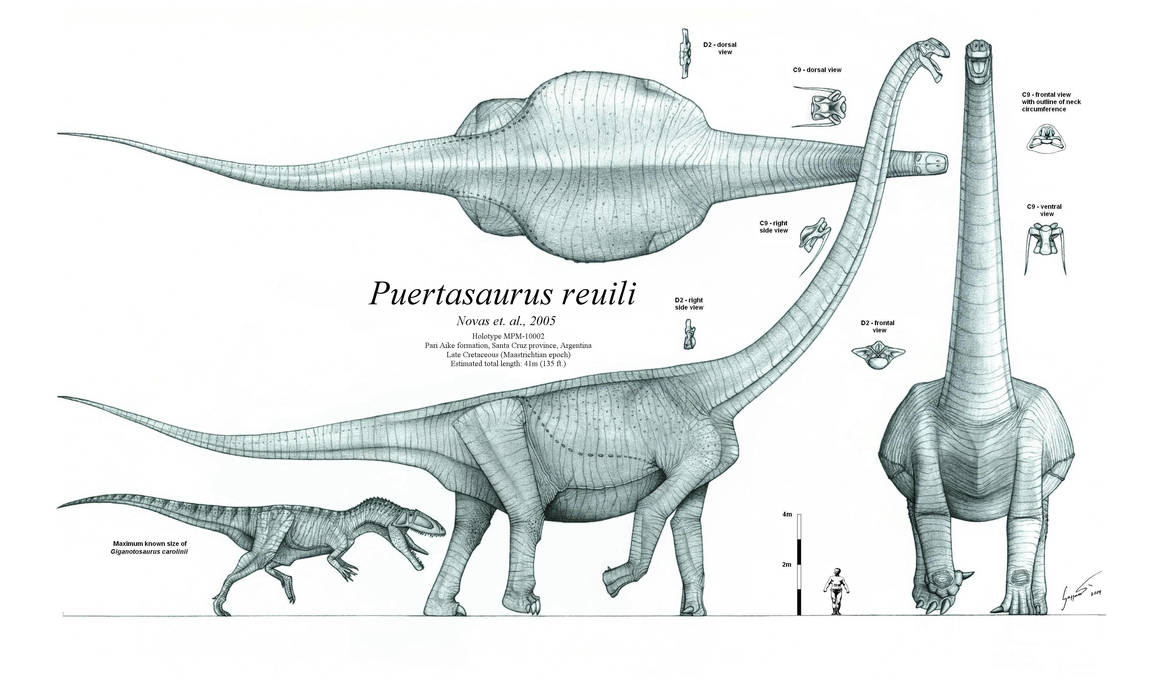
Discovered in southern Argentina, Puertasaurus was another titanosaur that pushed the limits of dinosaur size. With an estimated length of 100 feet and a weight of 55 to 60 tons, it was one of the largest land animals ever to walk the Earth. Puertasaurus lived during the Late Cretaceous period, alongside other titans such as Argentinosaurus and Patagotitan. Its neck vertebrae were massive, suggesting a powerful neck to support its large skull. Like other sauropods, it fed on high vegetation and had strong legs to carry its enormous bulk. The fossil remains of Puertasaurus are incomplete, but they still provide a glimpse into the immense size of this dinosaur. Its discovery added another piece to the puzzle of South America’s prehistoric giants.
Notocolossus

Notocolossus is one of the more recent giant dinosaurs to be discovered, found in Argentina in 2016. This titanosaur was estimated to be around 85 feet long and weighed as much as 60 tons. Its fossils included a large humerus, which suggested an immense forelimb strength. Notocolossus lived during the Late Cretaceous period, like many other titanosaurs, feeding on vast amounts of vegetation. Its powerful limbs and massive size likely deterred most predators. The discovery of Notocolossus highlighted the continued potential for finding new species of enormous dinosaurs in South America. Its immense size solidified its place among the largest land animals in history.
Giraffatitan
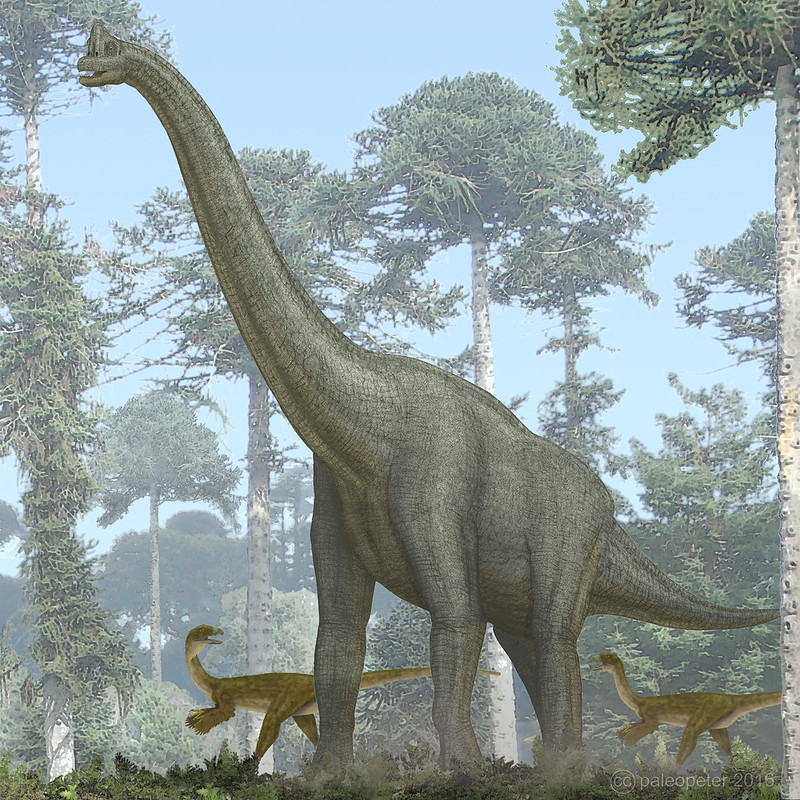
Giraffatitan, once thought to be a species of Brachiosaurus, was a towering sauropod from the Late Jurassic period. Reaching up to 82 feet in length, it stood out for its unusually tall, giraffe-like neck, which could stretch as high as 40 feet. Weighing around 37 tons, this dinosaur was lighter than some other giants but made up for it with height. Its fossils were discovered in Tanzania, Africa, in the early 20th century. Giraffatitan had a unique skeletal structure that allowed its long neck to rise vertically, unlike most sauropods that held their necks horizontally. It fed on high tree canopies, giving it access to food sources unavailable to others. Its towering presence likely made it a dominant species in its environment.
Brachiosaurus
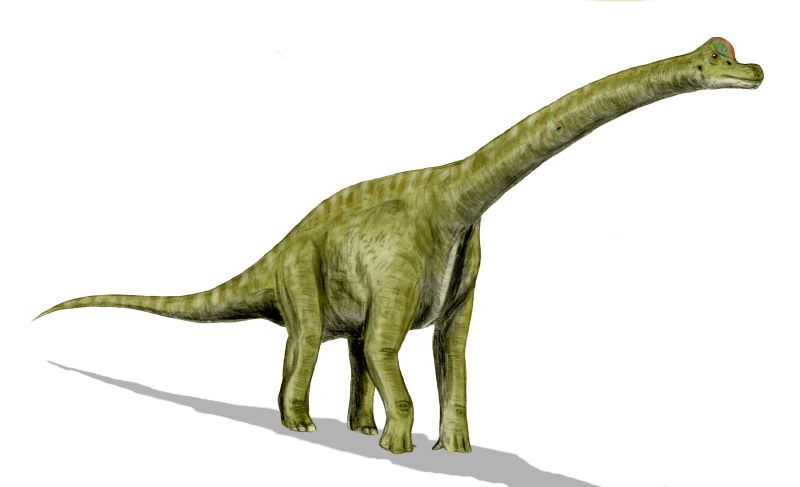
Brachiosaurus, one of the most famous dinosaurs, was another giant from the Jurassic period, known for its unique posture. Measuring about 85 feet in length and weighing up to 56 tons, it had longer front legs than hind legs, giving it a distinct sloped appearance. This body structure allowed Brachiosaurus to reach even higher into the trees than most sauropods. Its fossils were found in North America, mainly in Colorado, and it lived around 150 million years ago. Brachiosaurus had a large nasal opening at the top of its head, possibly used for communication or cooling. It fed on high vegetation, consuming large quantities of plants to sustain its massive body. Its towering neck made it an iconic figure among the dinosaur giants.
Turiasaurus
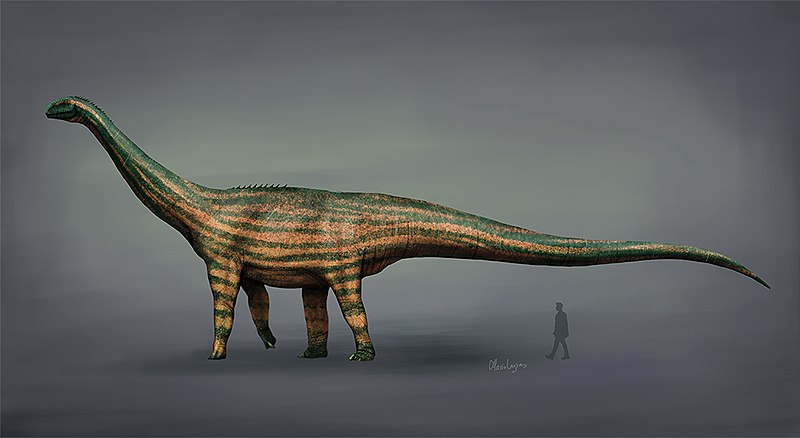
Turiasaurus was one of the largest dinosaurs discovered in Europe, with a length of around 98 feet and a weight of 40 to 48 tons. This sauropod lived during the Late Jurassic period and was found in Spain. Its fossils, discovered in 2006, revealed a large, robust body and long tail. Turiasaurus had thick limb bones, indicating it was built for supporting heavy weight. It likely fed on a diet of conifers and other tall trees, using its long neck to reach high branches. Despite its massive size, Turiasaurus was relatively nimble, as indicated by its limb proportions. Its discovery was a significant addition to the knowledge of large dinosaurs in Europe.
Diplodocus
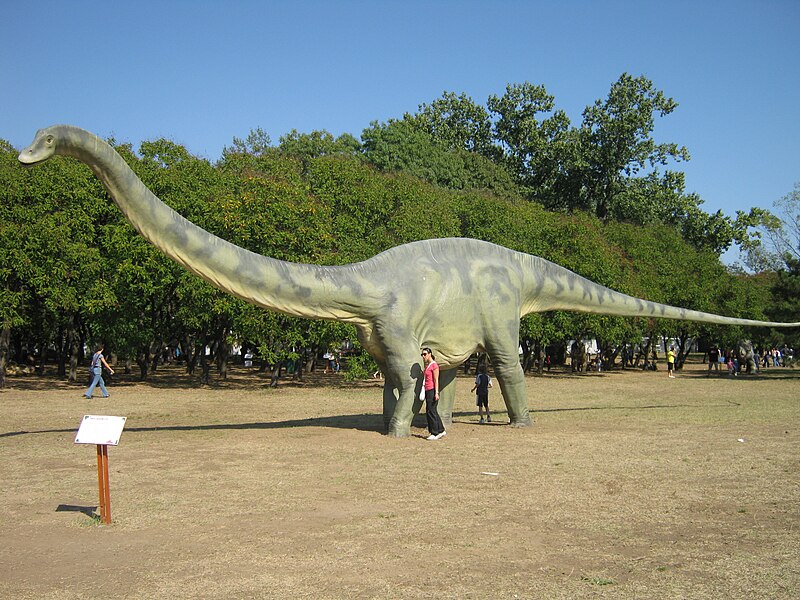
Diplodocus was one of the longest dinosaurs, measuring up to 90 feet from head to tail. This Late Jurassic sauropod was discovered in North America and lived around 150 million years ago. Unlike other giant dinosaurs, Diplodocus had a relatively lightweight body, weighing only about 15 tons. Its long, whip-like tail was one of its most distinguishing features, possibly used for defense or communication. Diplodocus had a long neck, which it used to feed on low-lying vegetation rather than high trees. Its fossils are among the most complete ever found for a large dinosaur, giving scientists detailed insight into its anatomy. This dinosaur’s sleek, elongated form made it a fascinating example of sauropod diversity.
Austroposeidon
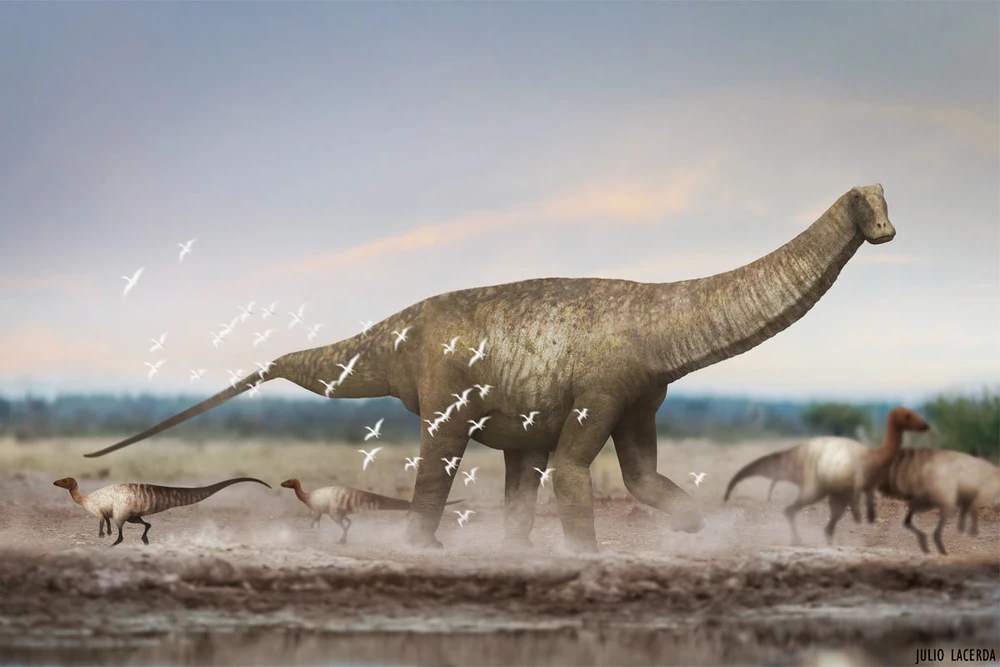
Austroposeidon, discovered in Brazil, was a massive titanosaur from the Late Cretaceous period. Measuring about 85 feet in length and weighing around 40 tons, this dinosaur was one of the largest ever found in South America. Its fossils were unearthed in 1953 but weren’t fully studied until 2016, when scientists finally realized the significance of the find. Austroposeidon had a long neck and tail, typical of titanosaurs, and lived in a lush, forested environment. Its large, robust limbs were necessary to support its immense body as it grazed on treetops. The discovery of Austroposeidon added to the growing list of massive dinosaurs found in South America, solidifying the region as a hotspot for giant sauropod discoveries. Its study also provided valuable insights into the diversity of titanosaurs in Brazil during the Late Cretaceous.
Mamenchisaurus

Mamenchisaurus, famous for its extraordinarily long neck, was a giant sauropod from the Late Jurassic period. This Chinese dinosaur reached lengths of up to 85 feet, with its neck alone making up nearly half its total length. It weighed around 20 tons, making it lighter than some of the other giants but still impressively massive. Mamenchisaurus’s neck was supported by elongated vertebrae, allowing it to reach vegetation in tall trees. Its fossils, discovered in the Sichuan Province of China, have helped scientists understand sauropod neck evolution. Mamenchisaurus moved slowly due to its size, but its long neck enabled it to feed over a large area without needing to relocate frequently. Its unique anatomy makes it one of the most distinct of the large dinosaurs.
Titanosaurus
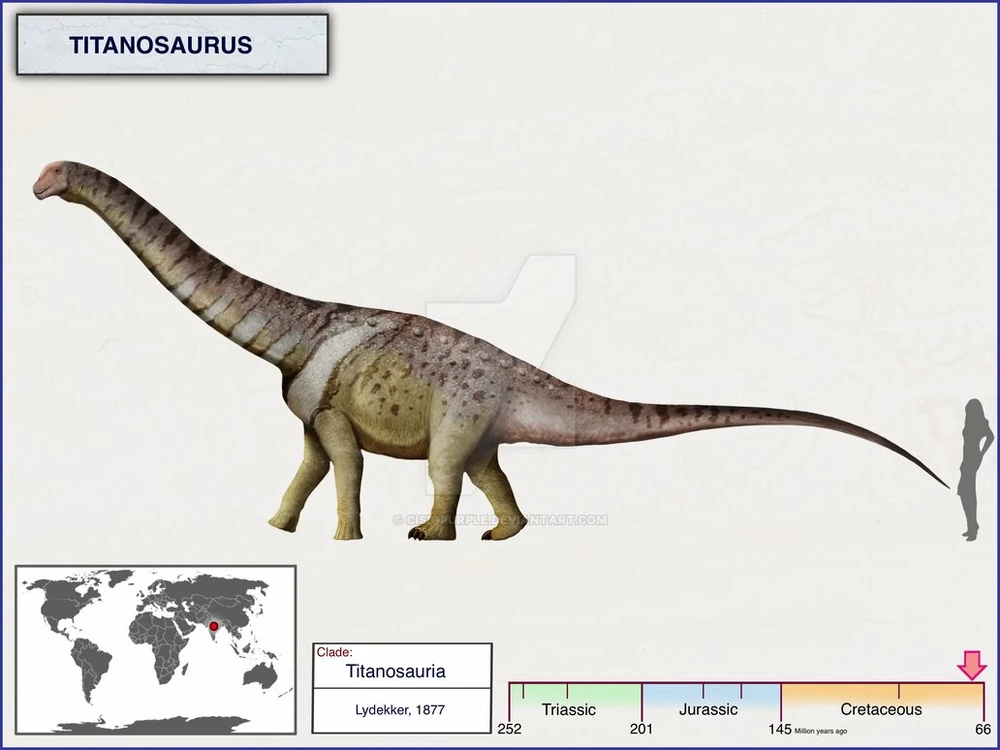
Titanosaurus, a genus that lends its name to the entire group of titanosaurs, was discovered in India and lived during the Late Cretaceous period. This dinosaur measured about 40 to 50 feet in length and weighed around 13 tons, which is smaller compared to other titanosaurs. However, Titanosaurus is important due to its widespread fossils found in Asia, Africa, and South America. Its long neck, large body, and column-like legs are typical of sauropods, but it had distinctive vertebrae with air-filled cavities to reduce weight. Titanosaurus likely fed on low-lying plants and shrubs, contributing to the ecosystems it inhabited. Though not the largest, its discovery led to a better understanding of the evolutionary success of titanosaurs across multiple continents.
Shingopana
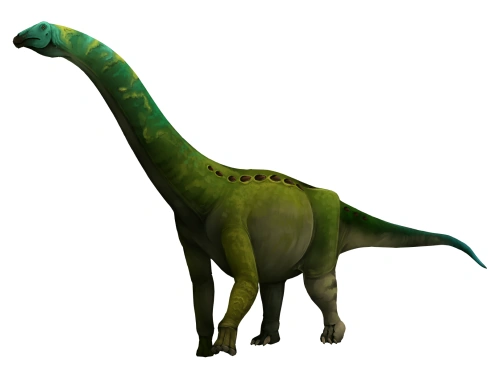
Shingopana, a lesser-known titanosaur, was discovered in Tanzania and lived during the Late Cretaceous period. This dinosaur reached about 26 feet in length and weighed approximately 6 tons. Though smaller than the behemoths of its group, Shingopana’s fossils provide valuable insights into African sauropods. Its name, meaning “wide neck” in Swahili, highlights one of its unique features—an unusually broad neck for its size. Shingopana’s fossils also show evidence of bone disease, offering rare insights into the health conditions of ancient dinosaurs. Its discovery in Africa helps fill gaps in the fossil record, showing that titanosaurs thrived on all continents. The study of Shingopana underscores the diversity of sauropods, even among smaller species.
Brontosaurus
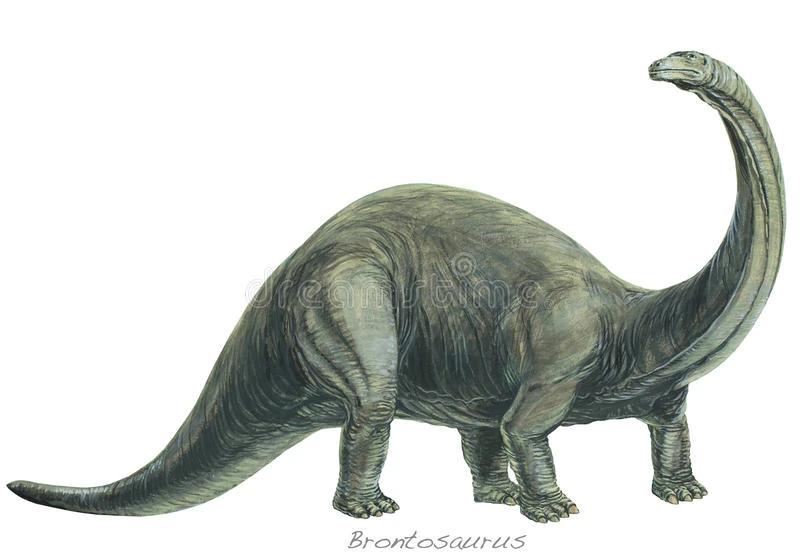
Brontosaurus, one of the most famous dinosaurs, was a giant herbivore that roamed North America during the Late Jurassic period. Reaching up to 75 feet in length and weighing about 15 tons, Brontosaurus was once mistakenly grouped with Apatosaurus but has since regained its separate status. Its long neck and massive body were characteristic of sauropods, allowing it to graze on tall vegetation. Despite its size, Brontosaurus had relatively small, peg-like teeth for stripping leaves from branches. It moved on four sturdy legs and had a long, whip-like tail. Brontosaurus fossils, discovered in the late 19th century, played a crucial role in popularizing dinosaurs in the public imagination. Its iconic silhouette remains one of the most recognizable among dinosaurs today.
Camarasaurus

Camarasaurus, though not the largest sauropod, was still an impressive dinosaur, reaching lengths of up to 60 feet. This Late Jurassic dinosaur lived in what is now North America, and it weighed around 20 tons. Camarasaurus had a shorter neck than some of its sauropod relatives but made up for it with a robust and muscular body. Its teeth were stronger and more spoon-shaped, allowing it to chew tougher vegetation compared to other sauropods. Fossils of Camarasaurus are among the most complete, giving paleontologists a detailed understanding of its anatomy. It had a relatively short tail, unlike the whip-like tails of Diplodocus or Brachiosaurus. The discovery of Camarasaurus fossils in the American West has been crucial in piecing together the puzzle of Late Jurassic ecosystems.
This article originally appeared on Rarest.org.
More From Rarest.Org
Castles are some of the most enduring symbols of history, offering a glimpse into the past through their architecture and stories. These ancient fortresses have witnessed the rise and fall of empires, serving as both military strongholds and royal residences. Read more.
Hockey is known for its speed and intensity, but some players have defied age to stay on the ice well into their 40s and 50s. These athletes not only prolonged their careers but did so at an elite level. Read more.
Throughout history, churches have served as spiritual centers and architectural marvels, reflecting the religious, cultural, and historical significance of their time. Some of the oldest ones in the world date back as far as the 1st century AD and offer a glimpse into the origins of Christian worship. Read more.



